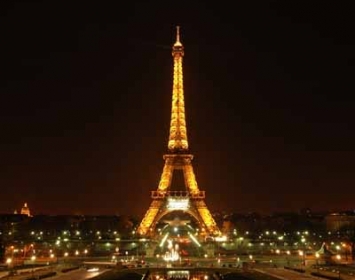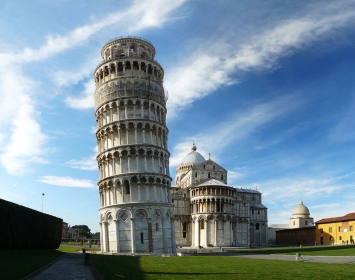Letölthető tartalmak
The Leaning Tower of Pisa
.jpg)
The Leaning Tower of Pisa is a building in Pisa, Italy. It is a bell tower. The circular bell tower stands next to Pisa’s cathedral. It is famous because it leans to one side, and it looks like it might fall over. Over the years, the tower became a symbol of Italy and an important tourist attraction.
By 1990, the top floor leaned 17 feet (520 cm) to the south. Several attempts were made to straighten the tower, but some of them made the situation even worse. A lot of restoration work has been done so far to stop it from falling over completely.
The height of the tower is about 55 metres from the ground. Its weight is about 14,500 tonnes. It now leans at about 3.99 degrees. The tower has 294 steps leading to 7 bells at the top. The outside of the tower is decorated with arches and columns.The construction of the tower began in 1173. After the third floor was built in 1178, the tower started to lean, due to having a small three-meter foundation in soft soil. The design of the tower was bad from the beginning. Shortly afterwards, constructions had to stop and didn’t continue until 1275 because Pisa was at war. Then the next three floors were built even with the ground to try to correct the lean. When they were finished, the tower leaned to the south. Finally, the last two floors were added in 1350.
During the long building delays, the tower’s weight compresses the ground under it, which strengthened its base enough to keep it from falling, even though it still leaned a bit more each year. The tower actually leans because it’s too heavy for the ground it is built on. The uneven layers of sand and clay beneath it have caused the tower to sink more in certain places.
In 1990, the Italian government closed the tower to the public and began a 10-year effort to stabilize the situation. A group of international experts tried different solutions, but nothing worked. Then, in 1999, a British engineering professor found a solution to the problem. The soil was removed slowly from the high side, so that the tower could settle back into the ground. This proved to be successful and by 2001 the tower was 16 inches (40 cm) straighter. The building is said to be safe for at least for another 300 years. The tower re-opened to the public in June 2001.
bell tower [bel ˈtaʊə] – harangtorony
circular [ˈsɜːkjʊlə] – kör alakú
to lean – [tə liːn] dől
attempt [əˈtempt] – kísérlet
to straighten [tə ˈstreɪtən] – kiegyenesít
restoration [ˌrestəˈreɪʃən] – felújítás, visszaállítás
to fall over [tə fɔːl ˈəʊvə] – eldőlni
height [haɪt] – magasság
weight [weɪt] – súly
degree [dɪˈɡriː] – fok
to lead to [tə liːd tuː] – valamihez vezet
outside of [ˌaʊtˈsaɪd ɒv] – valaminek a külseje
decorated with [ˈdekəreɪtɪd wɪð] – valamivel díszítve van
arch [ɑːtʃ] – boltív
column [ˈkɒləm] – oszlop
construction [kənˈstrʌkʃən] – építkezés
foundation [faʊnˈdeɪʃən] – alapozás, alap
soft soil [sɒft sɔɪl] – puha talaj
shortly afterwards [ˈʃɔːtli ˈɑːftəwədz] – nem sokkal később
to add [tu æd] – hozzáad
delay [dɪˈleɪ] – késleltetés
to compress [tə kəmˈpres] – összenyom, összeprésel
ground [ɡraʊnd] – föld, talaj
to strengthen [tə ˈstreŋθən] – megerősít
base [beɪs] – alap
uneven [ʌnˈiːvən] – egyenetlen
layer [ˈleɪə] – réteg
clay [kleɪ] – agyag
beneath [bɪˈniːθ] – alatt
government [ˈɡʌvənmənt] – kormány (országé)
effort [ˈefət] – erőfeszítés
expert [ˈekspɜːt] – szakember

-scaled.jpg)








